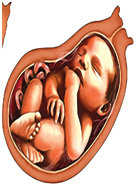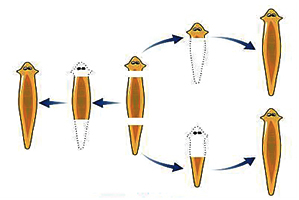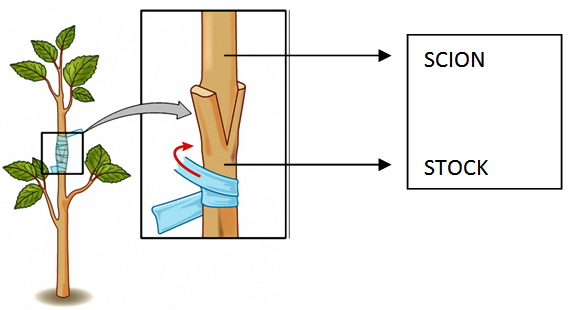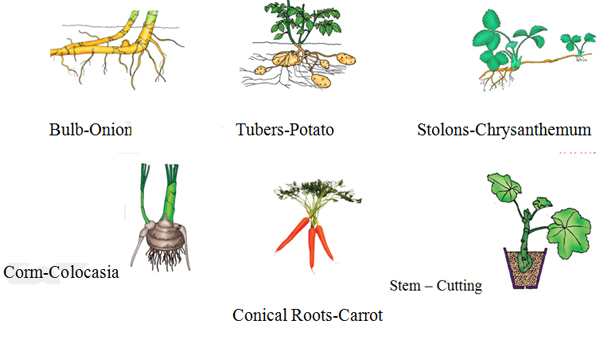6.Reproduction – The Generating System
Reproduction – The Generating System

Synopsis:
- Reproduction is necessary for life process for continuation of life, by the production of offspring.
- Reproduction is of two kinds: 1. Sexual reproduction 2. Asexual reproduction.
- Asexual reproduction involves a single parent that is without involving gametes.
- The different methods of sexual reproduction are fission, budding, fragmentation, parthenogenesis, regeneration, spore formation.
- In higher plants vegetative propagation is of 2 types. They are natural and artificial propagations.
- In natural vegetative propagation, new plants are produced from vegetative parts like leaves, stems, roots, etc.
- Artificial vegetative propagation is done through cutting, layering and grafting.
- In tissue culture few cells or plant tissues are placed in a growth medium with plant hormones in it and it grows into new plants.
- Fungi reproduce asexually through spore formation.
- In grafting, we can obtain a plant with desirable characters.
- Sexual reproduction involves fusion of male and female gametes.
- Union of male and female gametes is known as sexual reproduction.
- Fertilisation is of 2 types: 1. External fertilisation and 2. Internal fertilisation.
- The male reproductive system consists of a pair of testis, accessory glands and a system of ducts.
- Testes are the male reproductive organ and produce spermatozoa or sperms and also secrete the male sex hormone called testosterone.
- Accessory glands include one prostrate and 2 Cowper glands which secrete a fluid called semen.
- The duct system consists of vas eferentia, epididymis, vas deference, etc;
- The sperm cell is a flagellated structure with long tail which helps it to move towards the ovum.
- Men produce sperm starting from the age of about 13 or 14 years and continue throughout the life.
- A pair of ovaries is the reproductive organs in woman.
- Graafian follicles of ovary produce ova.
- In human beings fertilisation occurs in fallopian tubes.
- Placenta is a tissue formed by the cells from the embryo and the mother and it supplies nutrients to the embryo.
- Chorion and Amnion are the membranes formed by the growing embryo.
- Umbilical cord connects embryo with placenta.
- The gestation period in human beings is 9 months or 280 days.
- The reproductive parts of the flower that contain sex cells or germ cells are stamens and carpels.
- Union of one sperm with the egg is fertilization and the second sperm with the fusion nucleus is known as double fertilization.
- Continuation of life starts from either those of the general body or the sex cells.
- The number of chromosomes in man is 46.
- Cells divide for the growth of the individual to repair and replace the wear out cells and also for the formation of gametes.
- Cell division is of 2 types: 1. Mitosis or somatic cell division and 2. Meiosis or reproductive cell division.
- Somatic cells from the body of the organisms while germ cells participate in reproduction.
- Interphase can be divided into 3 phases. They are G1 phase, S phase and G2 phase.
- Prophase, Metaphase, Anaphase and Telophase are the different stages in mitosis.
- Meiosis has 2 phases, during first phase the parent cell divides twice.
- The second phase of meiosis is similar to normal mitosis.
- Division of cytoplasm is cytokinesis and division of nucleus is karyokinesis.
- After mitosis 2 daughter cells are formed whereas after meiosis 4 daughter cells are formed.
- Sexual act maturation does not necessarily mean that the body or mind is ready for sexual acts.
- Sexual act transmits many diseases called Gonorrhea, Syphilis and AIDS.
- Andhra Pradesh has the highest number of HIV patients in the country.
- Contraception to avoid pregnancy can be achieved by the use of condoms, oral pills, copper-T and surgical methods like vasectomy and tubectomy.
- Teenage motherhood should be avoided.
- Girls below 18 years of age should not be married.
- Male and female child sex ratio is declining due to female foeticide.
- As a citizen of India, we should have knowledge of reproductive health not only to control high population growth but also to create a healthy society.
4 Marks Questions and Answers
- Write difference between.
A) Asexual Reproduction – Sexual Reproduction
b) Stamen – Carpel
Asexual Reproduction
Sexual Reproduction
- There is no production of gametes.
- Male and female gametes are formed.
- It involves a single organism.
2). It involves one (or) two organisms.
- There is no fusion of gametes.
3). It involves male and female gametes.
- It requires only mitotic divisions.
4). It requires meiotic followed by mitotic divisions.
- Offspring produced by this way, are identical to the parent.
5). Offspring will have some characters from male parent and others from female parent. Some characters may not be present in either of the parents.
- It is not very useful for natural selection in evolution of species.
6). It is very vital for natural selection in evolution of species.
- It occurs by budding fission…etc.
7). It occurs due to pollination and fertilization.
- Genetic variation may takes place only through mutations.
8).More chance for genetic variation.
Stamen
Carpel
- Stamens produce male sex cells in the pollen grain.
1). Carpels produce female sex cells in ovules inside ovaries.
- These constitute male reproductive part of the flower.
2). These constitute female reproductive part of the flower.
- Each stamen is made up to filament and anther.
3). Carpel consists of ovary, style and stigma.
- Each anther consists of two lobes and each lobe has pollen chambers.
4). Ovules are attached to the ovary by a cushion like structures called placenta.
-
Explain the process of fertilization in plants.
Ans.- Fertilization is the process in which fusion of male and female gametes occurs resulting in the formation of zygote.9558
- Pollen grains reach, the surface of the stigma. This is called ‘pollination’.
- Pollen grains received by the stigma germinate and give rise to pollen tubes. Only one pollen tube finally reaches the embryo sac.
- The tube will have two male gametes which migrate to the tip of the pollen tube at the time of fertilization.
- Generally, the pollen tube enters the ovule through micropyle and is discharged the two male gametes into its embryo sac.
- One male gamete approaches the egg and fuses with it to from a diploid zygote. This is first fertilization.
- The other male gamete reaches secondary nucleus (2x) or fusion nucleus and fuses with it to form “endosperm nucleus” which will be triploid. This is second fertilization in the embryo sac.
- The fertilization take place twice in the embryo sac
- What are the different modes of asexual reproduction? Write them with examples. ?
Ans. In organism the following methods of asexual reproduction takes place.

A) Fission :- In unicelluar organisms like paramecium and bacteria, reproduce by splitting into two or more offsprings.
- This usually occurs in a symmetrical manner. They split into two by binary fission. When more cells are formed it is called ‘multiple fission’.
- This is the only mode of reproduction in these organisms.
B) Budding :

- A growth on the body as a bud that grows to form a nearly identical copy of parent.
- When the bud totally grows them it separates from the parent and survives independently. Ex: Yeast and Hydra.
C) Fragmentation :

- In flatworms, moulds, lichens, spirogyra etc., fragmentation takes place. A separate piece of parent organism can grow into a separate individual. (This may be from any part of the parent organism)
- Fragmentation is a common mode of reproduction in algae, fungi and many land plants.
D) Parthenogenesis:- This is a process of reproduction. There is a shift from sexual to asexual mode or reproduction.
- In this process generally the female gametes develops into zygote without fertilization.
- The same process is utilised in getting seedless fruits.
- In bees, wasps and ants, when egg divides and develops males are formed, while an undivided egg gives rise to female.
Regeneration:- Many organisms have the ability to give rise to new individual organisms from their body parts.
- If the individual is somehow cut or broken up into many pieces, these pieces grow into separate individuals. This is similar to fragmentation.
-
How are sperm cells adapted for their function?
Ans:- Sperms are the male gametes.
- . Millions of sperms are produced by the testes.
- These are microscopic and single celled.
- Each sperm has a head, a middle piece and a tail.
- The head bears a nucleus. It gets energy from mitochondria present in the middle piece.
- Tail helps in swimming to reach the ovum.
- Millions of sperms compete to fertilize the ovum.
- Semen provides nutrients for sperm to keep alive and helps as a medium for the movement of sperms.
-
The menstrual cycle prepares the uterus for a fertilized egg. How long is an average menstrual cycle from start to finish?
Ans :- The uterus at the time of fertilization is beautifully adapted to receive the developing embryo, providing it with food and disposing of its wastes.
- A few days prior to this time, the uterus was normal in condition.
- When the zygote is about to enter, the uterus enlarges and become much larger. It’s inner wall is thick, soft and moist with fluid, it’s blood supply is greatly increased.
- The menstrual cycle begins at the age of 14 or 15 and ends at the age of 48 to 50 years in women. Menstruation cycle takes place once every 28 days from the age of puberty.
- Ovulation takes place on the 14th day of the beginning of menstrual cycle 0f 28 days.
-
What are the advantages of sexual reproduction?
Ans:- Sexual reproduction leads to a great variety in population.
- Sexual reproduction promotes diversity of characters in the offsprings by providing genetic variation.
- Sexual reproduction plays an important role in the origin of new species having different characteristics.
- This genetic variation leads to the continuous evolution of various species to from better and still better organisms.
- All these are not possible in the case of asexual reproduction.
-
Write the difference between Mitosis and Meiosis?
Mitosis
Meiosis
1. Occurs in somatic cells
1. Occurs in germ cells.
2. Nucleus divides only once
2.Nucleus divides twice
3. Two daughter cells are formed
3. Four daughter cells are formed
4. Daughter cells are diploid
4. Daughter cells are haploid
5. Occurs more frequently
5. Occurs less frequently
6. Daughter cells from somatic organs
6. Daughter cells from gametes
7. There is only one prophase, one metaphase, one anaphase and one telephase
7. There are two each phase and five sub phases in prophase
8. Number of chromosomes not changed in the cells
8. Number of chromosomes is reduced by half
9. Chromosome number doubles at the beginning of each cell division
9. Chromosome number is not doubled at the beginning of cell division. it doubles after the end of first meiotic division
10. No crossing over in chromosomes
10. Crossing over in chromosomes
- Vicky’s father wants to grow a single plant having two desirable characters colourful flowers and big fruits what method will you suggest him and why?
SCION STOCK
Ans:- I will suggest her to follow “grafting method” to get the plant with desired characters.
- . In this method, two plants, with desired characters are joined together in such a way that two stems join and grow as a single plant.
- The plant which is attached to the soil is called stock and the cut stem of another plant without roots is called ‘scion’.
- Both the stock and scion are tied with the help of twine thread and covered by a polythene cover.
- Grafting is used to obtain a plant with desired desirable characters.
- This technique is very useful in propagating improved varieties of various flower ` and fruit.
-
Visit a nearby village and collect information how farmers grow sugarcane, flowering plants like chrysanthemum, prime rose and vegetables like stem tubers, plump gourd (Dondakaya) etc. make a report and submit in class?
Ans: I visited my village Veluru and collected the information about artificial propagation methods in different plants.
Sl.No.
Method Of Propagation
Plants Growing Under This Method
1
Cutting
Rose, bougainvillea, chrysanthemum, grapes, sugarcane, bananas, carrot and cactus etc. are grown by “cutting”.
2
Layering
Jasmine, strawberry, raspberry, lemon, guava, hibiscus (china rose) and many slender ornamental plants.
3
Grafting
Fruit tree, flowering bushes, apples, peach, apricot and pear trees are often grafted.
4
Planting tubers
Potato
- Collect information from school library or using internet what vegetative methods are followed in your districts as well as in your state to propagate various plants of economic importance. Represent it in graph.

Bulb-Onion Tubers-Potato Stolons-Chrysanthemum Corm-Colocasia Conical Roots-Carrot Stem – Cutting
Sl.No.
Economically important plants growing
Method followed
1
Carrot
Root cutting
2
Rose, bougainvullea
Stem cutting
3
Grapes, bananas, sugarcane
Stem cutting
4
Cactus
Stem cutting
Plant having economic value
Method of propagation
5
Chrysanthemum
Suckers
6
Garden grass
Nodes propagation
7
Potatoes
Eyes of tubers planting
8
Jasmine, Rose
Root layering, cleft grafting
9
Guava
Air layering, cleft grafting
10
Strawberry, Raspberry
Layering
11
Lemon, Hibiscus, Ornamental plants
Layering
12
Mango
Approach grafting and tongue grafting
13
Apple and orange
Bud grafting
-
Make a flow chart to show the cell cycle and explain cell division describing different stages of mitosis.
Ans: Mitosis1). Rophase
1. Chromosomes contract, spiral and become visible even in light microscope and nucleoli become smaller (material to chromosome)
2. Chromosomes split lengthwise to from chromatids, connected by centromeres
3. Nuclear membrane breaks down
4. Centrosome, containing rod-like centrioles, divide and form ends of spindle (probably animals cell only)
2). Metaphse
1. Chromosomes move to spindle equator, centromeres attached to spindle fibres.
2. Centromeres split, separating the chromatids.
3. Anaphase
1. Spindle fibres attached to centromeres contract, pulling chromatids to wards poles
4). Telophase
1. Chromatids elongate, become invisible (replication at this stage to become chromosomes)
2. Nuclear membranes from round daughter nuclei
3. Cell membrane pinches into from daughter cell (animals) or new cell wall material becomes laid down across spindle equator (plants)
4. Nucleus divides into two and division of cytoplasm starts
-
Observe the following part of a flowering plant prepare a note.
Ans:- This is the diagram showing the structure of ovule.
- . An ovule is an egg shaped structure attached by a stalk to the inner side of the ovary.
- At the centre of each ovule is a microscopic embryo sac filled with food and water.
- The embryo sac is composed of gametophyte cells.
- The majority of flowering plants have an embryo sac consisting of seven cells and eight nuclei.
- The structure which receives pollen is called stigma and the long tube like structure which helps in the passage of compatible male sex cells is called ‘style’.
-
How will you appreciate cell division that helps in perpetuation of life?
Ans:- Continuation of life starts from cells either those of the general body or the gametes.
- . Cells arises from the pre-existing cells through cell division.
- The characters of the parents are inherited through chromosomes which participate in the cell division.
- In cell division, the cell divides into two halves with equal number of chromosomes which are similar to parent cell and are diploid in nature all the somatic organs of our body are built through this division, called mitosis.
- Meiosis helps to maintain the same number chromosomes in daughter cells and inheriting characters in the gametes.
- Thus from zygote (2x) to the complete body formation cell division play very important role which results in perpetuation of life.
- Hence, we have to really appreciate the role of cell division in the contribution of life on the earth.
- How do you demonstrate the formation of bacterial colony in milk?
Ans: Aim: To demonstrate the formation of bacterial colony milk.
Requirements: Glass of milk, small quantity of curd, bowl.
Procedure:- Take a teaspoon full of curd and mix it thoroughly with around 30 teaspoon full of lukewarm milk in a bowl.
- Take another teaspoon full of curd and mix it with 30 teaspoon full of cold milk in another bowl.
- Cover both the bowls and note the time taken Observation: curdling occurs in the bowl having lukewarm milk.
Inference: Curdling indicates the increase of lactobacillus bacteria in the lukewarm milk bowl. Cold milk has not provided the medium for the rapid growth of lactobacillus. Hence, in cold milk bowl curdling could not occur.
- How do you demonstrate the growth of Rhizopus on bread?

Rhizopus Sporangium
Ans: Aim: To show the growth of Rhizopus on bread and observation of its spores.
Requirements: Slice of bread, microscope, mould sample, plain glass slide, cover slip, water, disposable gloves.- Take the slice of bread that is preservative free. Leave it in the open air for about an hour so it is exposed to the contaminated air.
- Place the bread in a plastic bag, sprinkle water over it to have dampness then seal the bag leaving some air inside.
- Place the bag in a dark warm place near the kitchen cupboard.
- Mould will grow best in a moist environment they start growing in 2-3 days.
- Check on the piece of bread every few days, and add more water if it is drying. Avoid opening of the bag.
- When sufficient mould has formed, prepare a slide and examine it under the microscope.
Observation: I would find whitish thread like growth with masses of black, grey and green fine dotted structures.
The black dotted structure is that of bread mould with the help of the class teacher I will prepare a slide and observe under microscope.
- Place a drop of water in the center of the slide.
- Using a toothpick, scrape very little of the mould and place it on the drop of water.
- Take the cover slip and set it at an angle to the side so that one edge of it touches the water drop, then carefully lower it over the drop so that the cover slip covers the specimen without trapping air bubbles underneath.
- Use the corner of a tissue paper or blotting paper to blot up any excess water at the edges of the cover slip.
- View the slide with a compound microscope, first observe under low power.
Inference:
The common bread mould consists of fine thread like projections called hyphae and thin stems having knob like structures called sporangia each sporangia contain hundreds of minute spores. When the sporangium bursts, the tiny spores are dispersed in air.
- How do you observe pollen grain in your class?
Ans: Aim:To observe the structure of pollen grain.
Materials Required: Slide, marigold flower, water, compound
microscope.
Procedure:- Take a slide and put a few drops of water on it.
- Now take the flower like marigold, tap it over the drop of water.
- I will see small dot like structures in water. These are pollen grains.
Observation: ball like structures appeared, called pollen. Two nuclei are present in the pollen grain. It has a pollen tube.
Inference: Pollen reach the stigma and fertilize the egg to from the zygote.
- How do you demonstrate the germination of seed in your science lab?
Ans: Aim:To demonstrate the germination of seed.
Materials required: Bengal gram seeds and water beaker.
Procedure:- Soak a few Bengal gram (Chana) seed in water breaker over night,
- Drain the excess water and cover the seeds with wet cloth. Leave them for a day.
- Keep sprinkling water at regular intervals so that they do not dry up open the seeds carefully and observe the parts
Observation: the germinating seed has cotyledons plumule and radicle as it pars.
- How do you observe the process of mitosis in your school lab?
Aim: Observation of stages in mitosis cell division.
Materials: Permanent slides which shows different stages in mitosis cell division from biology lab kit.
Procedure: Keep the permanent slides of mitosis under microscope and observe them carefully.
Observation: You can identify the different stages of mitosis and draw the neat diagrams of the mitosis cell division stages.
2 Marks Questions and Answers
-
Why do fish and frog produce a huge number of eggs each year?
Ans:- Fish and frogs are oviparous animals.
- They lay eggs in water which results in external fertilization
- There is high risk in external fertilization and minimizes the chances of fertilization due to external factors.
- If they lay eggs in little quantities, there will be no chance of fertilization because some of them may be washed away or become pray to predators. Hence, fish and frog lay eggs in huge number to improve the changes of fertilization.
-
Give examples and explain what is meant by external fertilization?
Ans:- If the fusion of sperm and ova occurs outside the body of the animal, it is called ‘external fertilization’.
- External fertilization mostly occurs in aquatic animals like fish and frog.
- The female lays a vast number of eggs in water and male release.
-
In what ways does sexual reproduction differs from asexual one? State at least three reasons.
Ans:- Sexual reproduction provides more chances for genetic variation.
- Sexual reproduction provides a source for natural selection.
- Offsprings will have some characters from male parent and others from female parent. Some characters may not be present in either of the parents.
- When the foetus is growing inside the uterus it needs nutrients. What provides these nutrients?
Ans :- After implantation a disk like special tissue develops between the uterus wall and the embryo which is called ‘placenta’.
- . The foetus is connected to placenta in mother’s body through umbilical cord.
- It is through the placenta that all the requirements of the developing foetus like nutrition, respiration and excretion etc., are met from the mother’s body.
- The exchange of nutrients, oxygen and waste materials between the embryo and the mother takes place through the placenta.
-
What is the job of the amniotic sac?
Ans:- The amnion grows around the embryo itself.
- The cavity within the amnion become filled with a fluid, called amniotic fluid.
- The embryo develops in the amniotic cavity, which keep the embryo moist and protects it from minor mechanical injury.
-
What does the mother’s blood take away from the baby and into the placenta?
Ans:- Under normal conditions, there is never a direct blood flow between mother and the young.
- .Their two blood systems are separated by thin membranes made up of cells that allow an exchange mainly by diffusion of oxygen, carbon dioxide, nutrients and waste materials.
-
How does reproduction help in providing stability to population of species?
Ans:- The production of new organisms from the existing organisms of the same species is known as reproduction.
- Reproduction is essential for the survival of a species on this earth.
- The process of reproduction ensures continuity of life on earth.
- Reproduction by human beings ensures that the human species will continue to exist on the earth for all the time to come.
- Reproduction give rise to more organisms with the same basic characteristics as their parents.
-
Draw labeled diagrams to explain plant fertilisation. Write few points about pollengrain.
Ans- The stamens contain some sac like structures at its head containing small ball like structures. These are called ‘pollen grains’.
- The pollen grains contain male gametocytes.
- These pollen reach the stigma and form pollen tube. Finally the male gametes are released into the embryosac and fertilisation occurs to form zygote.
-
What would be the consequences if there is no meiosis in organisms that reproduce sexually?
Ans:- If meiosis not occurs the chromosomal number will be doubled in the formed zygote.
- The characters of the offsprings are unusual and it may leads to the death of individual and eventually extinction of that species takes place but the situation is not like that.
- What precautions will you take to keep away from various sexually transmitted diseases?
Ans:- We should avoid unsafe sexual contacts.
- We should avoid using of infected devices.
- We should avoid the infected blood transfusion.
- We should use condoms and diaphragms which can prevent not only pregnancy but also some sexual transmitted diseases gonorrhea, syphilis and aids.
One Mark Questions and Answers
- What is placenta?
- Placenta is a tissue formed by the cells from the embryo and the mother.
- It is formed around 12 weeks of pregnancy and becomes an important structure for nourishment of the embryo.
- Write the function of placenta?
- Under normal conditions there is never a direct blood flow between mother and young.
- The blood vascular system of two are separated by thin membrane made up of cells that allow an exchange mainly by diffusion of O2, CO2 , nutrients and waste materials.
- What is umbilical cord? How is it formed?
- It is a tube like structure which contains the very important blood vessels that connect the embryo with placenta.
- It is formed when the edges of the amniotic folds come together around the stalks of the allantois and yolk sac.
- What did August Wiseman hypothesis about the number of chromosomes?
- In successive generations, individuals of the same species have the same number of chromosomes.
- In successive cell divisions, the number of chromosomes remains constant.
- How are the male and female animals produced in the bees, ants and wasps?
- In the bees, ants and wasps at the time of reproduction meiosis doesn’t occur and the egg can develop whether fertilized or not.
- Unfertilized eggs develop into monoploid offsprings that develops into males.
- Fertilized eggs develop into diploid offsprings that develop into females.
- What is layering?
- Layering is a vegetative propagation method in which a portion of an aerial stem grows roots while still attached to the parent plant and then detaches as an independent plant. Ex. Jasmine, grapevine and crotans.
- What is grafting?
- Grafting is a vegetative propagation method in which two plants are joined together in such a way that two stem join and grow as a single plant.
- This is commonly practiced in horticultural plants like mango, guava, sapota etc.
- What do you understand by the word stock?
- The lower part of the union which is attached to the soil, in grafting is called ‘stock’.
- What do you understand by the word stock?
- The upper part of the union in grafting which has lost its root system is called ‘scion’.
- What is fertilization?
- The process of fusion of male and female gametes to form zygote is called ‘fertilization’.
- What is meant by external fertilization?
- Fertilization that takes place outside the body of mother is called ‘external fertilisation’.
- Which hormone controls the secondary sexual events in man?
- The secondary sexual events in man are controlled by a male sex hormone called ‘testosterone’.
- What is meant by ovulation?
- Releasing of the egg or ovum by the rupturing of the ovarian follicle is called ‘ovulation’.
- What are the four embryonic membranes that help to nourish, protect and support the growing embryo?
- 1. Chorion, 2.Placenta, 3. Amnion and 4. Allantois are the four embryonic membranes that help to nourish, protect and support the growing embryo.
- What is foetus?
- From 3 months of pregnancy the embryo is called ‘foetus’.
- What is colostrum?
- Colostrum is watery lymph like fluid that accumulates in the mammary glands during the last part of the pregnancy.
- What is endosperm?
- Endosperm is the triploid cell formed by the fusion of sperm with secondary nucleus. It stores the food as the development of the ovule proceeds.
- What is a double fertilization?
- Union of one male gamete with the egg and the second male gamete with the secondary nucleus is called “double fertilization”. It occurs only in flowering plants.
- “Organisms produce differently in different situations.” Give an example.
- Paramoecium would divide asexually by fission in favourable conditions while during unfavourable conditions they undergo nearly sexual kind of reproduction called ‘conjugation’.
- What is budding? Give example.
- Budding is a form of asexual reproduction in which a growth on the body grows to form nearly identical copy of parent and then separates from parent and becomes independent. Ex. Yeast.
- What is parthenogenesis? Give example.
- Parthenogenesis is a type of asexual reproduction in which the egg develops without meiosis and fertilization. Ex. Bees, ants, Wasps and Rotifers
- What is regeneration? Give example.
- Many fully differentiated organisms have the ability to give rise to new individual organisms from cut pieces of their body parts. This process is called ‘Regeneration’. Ex. Planaria.
- Give examples of Sexually Transmitted Diseases [STDs].
- Bacterial infections such as Gonorrhea and syphilis, viral infections such as AIDS are some of the examples for STDs.
- What is the advantage of using condoms in addition to contraception?
- In addition to contraception, condoms are useful to prevent the transmission of some STDs.












